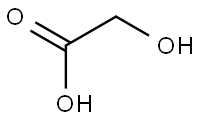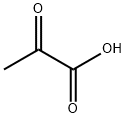
Glycolic acid synthesis
- Product Name:Glycolic acid
- CAS Number:79-14-1
- Molecular formula:C2H4O3
- Molecular Weight:76.05

96-35-5
343 suppliers
$5.00/5g

79-14-1
845 suppliers
$6.00/25g
Yield:79-14-1 100%
Reaction Conditions:
with water at 95 - 97; under 760.051 Torr; for 2 h;Reactive distillation;
Steps:
2-1.4 (4) Hydrolysis Reaction (Hydrolysis by Reactive Distillation)
As a reactive distillation apparatus, an apparatus obtained by connecting a 3-stage packed column to a flask and further providing a refluxing device at the top of the packed column was used. A mixed liquid obtained by mixing 150 g of water with 50 g of the distillate containing more than 98 wt % of methyl glycolate obtained in (3) above was put into the flask. Next, reactive distillation was carried out for 2 hours at normal pressure, maintaining the temperature at the base of the column of the reactive distillation apparatus (i.e. the liquid temperature) at 95 to 97° C. At this time, distillate containing methanol was distilled off. The temperature at the top of the column was 65° C. at the start of the reactive distillation, but had reached 100° C. by the end. [0322] After the reactive distillation had been completed, 114 g of an aqueous solution containing 36.1 wt % of glycolic acid was recovered from the flask. The yield of glycolic acid relative to the methyl glycolate was 100%. Regarding impurities, formaldehyde and chlorine compounds were not detected, and 20 ppm of oxalic acid and 76 ppm of ethylene glycol were detected.
References:
US2004/138409,2004,A1 Location in patent:Page 23

141-46-8
32 suppliers
inquiry

79-14-1
845 suppliers
$6.00/25g

56-81-5
1771 suppliers
$5.00/25g

79-14-1
845 suppliers
$6.00/25g

127-17-3
564 suppliers
$5.00/10g

79-14-1
845 suppliers
$6.00/25g
